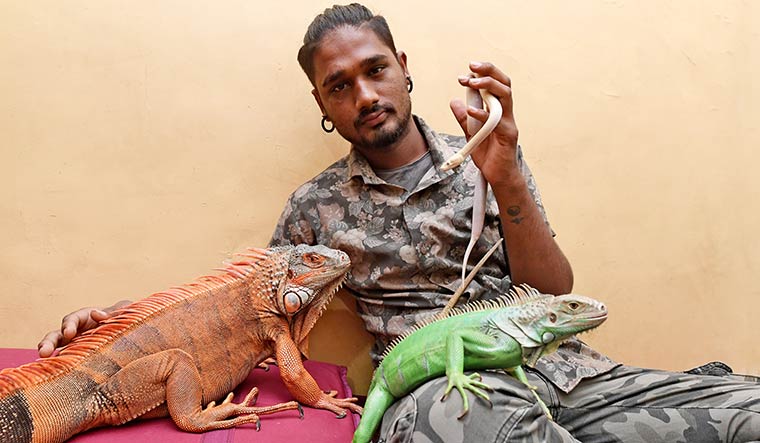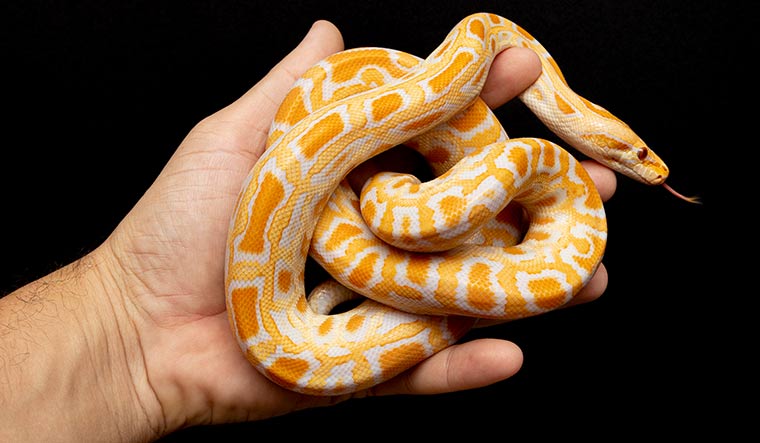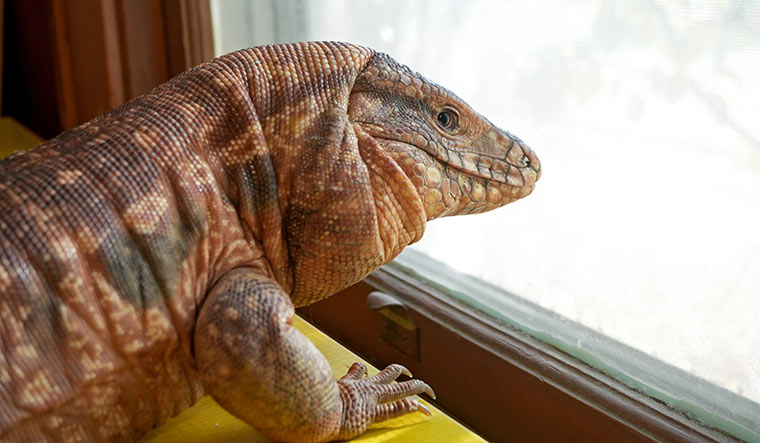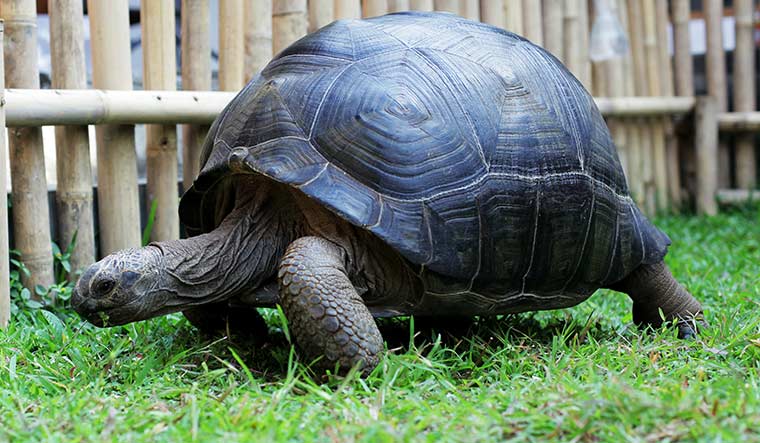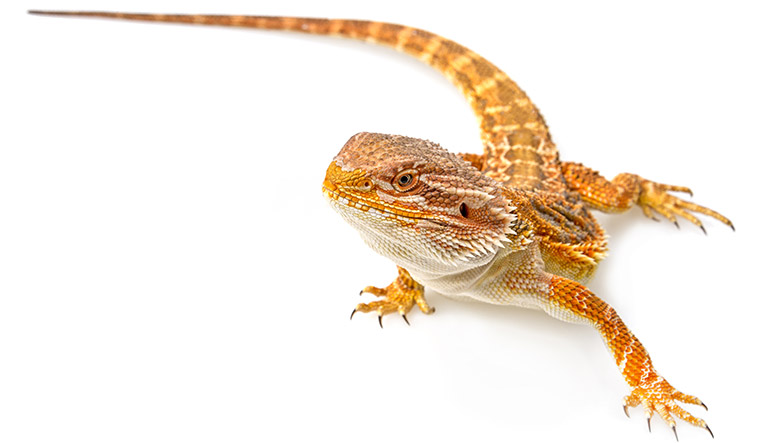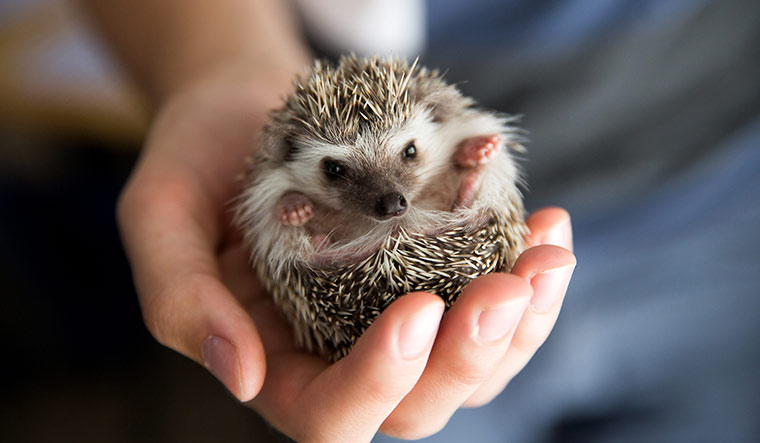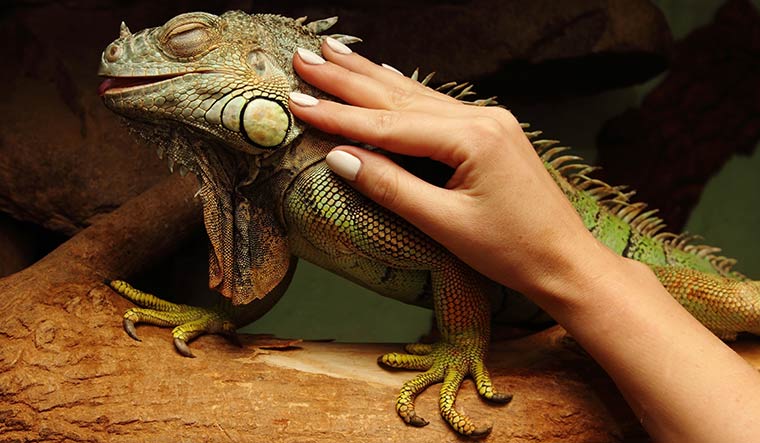Want to keep a green iguana as a pet?
Instruction manuals will ask you to keep a large space ready. The vegetarian lizard can grow up to six feet in a few years―like your own private Godzilla. Native to tropical Americas, these strong, sturdy, and mostly docile reptiles can deal out a bone-shattering blow with their tail when hungry or irritated.
Sheldon D’Souza, a 25-year-old entrepreneur from Chembur in Mumbai, reared five grown iguanas in his two bedroom flat during the lockdown months. At one point, his apartment was home to his mother, father, sister and himself, apart from two ball pythons, one tarantula, four hedgehogs, and the iguanas. “Pythons are useless. Hedgehogs can get aggressive. But nobody is scared of iguanas in my family. Even my dog is comfortable with them,” says D’Souza. They are fed a giant meal of coriander leaves, papayas, bananas, grapes and other vegetables and fruits every morning, lest they start jumping around like petulant little children, ready to bite.
D’Souza, himself, behaves like a child in a candy store in pet shops at Crawford Market. His former girlfriend, he says, would often lose pace with him as he zoomed around looking for exotic animal babies. “Our five year relationship ended over my pets,” says D’Souza, who knew where his priorities lay.
So tied up is D’Souza’s life with his menagerie that he cannot leave them alone in the house even for a day. When he visits his uncle, he carries the iguanas along on a motorcycle. Once he carried two adult iguanas on his shoulders, two smaller ones in a basket, and the fifth was swaddled by his father. “They are always calm and comfortable. They don’t mind new places. My cousins are fine with them,” says D’Souza nonchalantly.
Expert climbers, the arboreal iguanas spend nights on top of the cupboards in the house. D’Souza wants to buy a tegu next. Unlike an iguana, the blackish, scaly tegu is a carnivorous lizard and costs a hefty 142,000 for a hatchling.
Last we checked, it was the royalty or the rich and famous who cared about exotics. Napoleon Bonaparte’s wife Josephine had a collection which included black swans, llamas and kangaroos, among other curiosities. Queen Elizabeth II is believed to have held a funeral for her chameleon, which was a gift from Earl Mountbatten of Burma. Indian princes, noblemen and emperors often received them as gifts, like how Mir Jafar gifted a zebra to Jahangir, who was known to be a passionate naturalist. Michael Jackson gave interviews with his pet chimpanzee, Bubbles, and Mike Tyson once owned three Royal Bengal tigers!
The Ambanis are building a 280-acre zoo and animal rescue centre in Jamnagar, Gujarat, where komodo dragons and African lions will be the highlights. A pet project of Anant Ambani, it has been dubbed the “the world’s largest zoo” and is expected to open in 2023.
But now exotic pets are accessible by all and sundry.
When the government came out with a one-time voluntary disclosure scheme for exotic animals in 2020, over 32,000 Indians (all private individuals) from 25 states and five Union territories signed up. The pets ranged from critically endangered species like the black-and-white ruffed lemur from Madagascar and beisa (an East African antelope) to bearded dragons, pythons, marmosets and what not. Today Instagram is smothered with cutesy images of exotic reptiles, birds, mammals, insects and amphibians posted by hobbyists, dealers and resellers.
The growing demand for domesticating these exotics has created a whole new crisis in the world of Indian wildlife smuggling. Several illegal pet shops and animal markets are now cropping up all over the country, including in Murgi Chowk, Hyderabad, Mir Shikar Toli, Patna and Russell Market in Bengaluru. Twitter feeds and newspaper stories are throwing up news of dead reptiles seized from suitcases in airports and emaciated kangaroos being rescued on highway stretches. A quick Google search will reveal how the number of seizures of exotic wildlife in India has gone up since the amnesty disclosure scheme of 2020, especially in the northeast, with consignments pouring in via routes from Myanmar and Bangladesh. The Chennai airport is one of the biggest touch-points; the latest haul was on August 11, when a male passenger from Bangkok was caught with a De Brazza’s monkey, 15 king snakes, five ball pythons and two Aldabra tortoises. “Once these animals cross the border, there is no legal tool or authority in India to nab or track them.
India is no longer just a conduit country; it is actually a final destination for many of these species,” says Samyukta Chemudupati, head, wildlife forensics, Wildlife Conservation Trust in Mumbai.
Aside from the fact that these wild animals are rampantly objectified and commodified, they are kept and transported in stressful, inhumane conditions outside their natural habitats. “When the exotics come in, how do you raise them? What are their nutritional and dietary requirements, how do you care for them, how to keep them alive, all that standard operating procedure and expertise is not there in India,” says H.V. Girish, joint director at Wildlife Crime Control Bureau, under the environment ministry. “Veterinarians in India don’t even fully know how to care for our indigenous wildlife. So, how will they treat exotics? As a result, casualties are going up.” Girish talks about the complicated legal conundrum that India faces with respect to exotic animals. The Wildlife (Protection) Act, 1972, is quiet on exotic wildlife while deeming the trade and possession of native wildlife species as illegal. Traffickers and traders, therefore, make the most of this legal loophole.
While India is a signatory to CITES (Convention on International Trade in Endangered Species of Wild Fauna and Flora) since the 1970s, it is a category two country, and the regulations are, therefore, not fully implementable here. For India to become a category one country (like Chile, Malaysia, Morocco, Namibia or New Zealand), there is a need for a national legislation. The Wildlife (Protection) Amendment Bill, 2022, which was recently passed by the Lok Sabha, has CITES requirements woven into the amendments. If the bill is passed by the upper house in the winter session of Parliament and becomes a law, India will become a category one country in dealing with exotic wildlife.
Sumit Garg from Meerut has a farm in Bulandshahr where he stocks a full menagerie of giant iguanas, marmosets, porcupines, bearded dragons, tarantulas, hedgehogs and a variety of pythons. Exotic pets have been his passion and vocation for the last seven years. He is often seen cradling animals like the African spurred tortoise, the world’s third largest tortoise, or a pinstripe python on social media. “Trading of exotic pets is a big, big business in India. Some 60 per cent of my buyers are students who keep it as pets for a few months and sell it off at a neat profit. A morph of python, for example, typically sells for 040,000. We never know who the main guy procuring these animals are, but we are the second or third rung in the business. My buyers have a better knowledge of wild species and how to domesticate them than all the wildlife officers in India,” says Garg, before unveiling his plans. “People don’t respect wild things in this country. There is no awareness here. The closer you come to these animals, the more obsessed you will get. I will soon be building a mini zoo where I will teach children how to care for reptiles.”
Sanjeev Pednekar―founder of the Bengaluru-based pet sanctuary, Prani―got hooked when an education officer from World Wildlife Fund, M.K. Srinath, walked into his school with a three-foot rescued crocodile from Hebbar Lake. Today, Prani has 750 animals and 43 different species―from hedgehogs and emus to sting rays and lungfish. Most of them are exotics and 80 per cent of his animals are rescued or given up by people who could not take care of them, especially birds and red-eared slider turtles who grow out of standard aquariums as adults. There are no barricades or enclosures in Prani. Visitors learn how to approach and behave with these animals on the spot. “I will give you papers and a backstory for every animal I have. People can’t just leave their animals behind without doing a general power of attorney here,” says Pednekar, who gets slightly irritated when the question of legality comes up.
Pednekar jokes that the largest sellers of exotic animals must be the “custom guys” who do not know what to do with an undocumented animal once it enters India. “The Ambanis have the largest collection of exotic pets. Anant Ambani is sending private jets and housing everything in his house in Bombay. Is that illegal?” he asks categorically.
Snakes and lizards are the most traded exotic animals in the market right now because it is easy to smuggle them; they are easier to transport. “Just feed them one rat and they don’t need anything for 15 days. Some 200 kids who visited my sanctuary have already owned ball pythons for years,” says Pednekar who shows a video of a 10-foot-long reticulated python he helped rescue from the window sill of a house vacated by a 25-year-old tenant.
But Thilakrajkumar from Chennai, a 25-year-old engineer, living in a 3BHK flat with his parents and sister, talks about his Nile Monitor, the second-largest reptile in the Nile river, like it is as harmless as a cocker spaniel. Kumar and his brother are partners and between them, they manage nine farms in Chennai to grow their business of exotic pets. Not surprisingly, he has 80 pairs of iguanas, most of them are special mutations, like albino, crimson, snow or jet black. "Breeding reptiles is easy and they adapt to the Indian climate like a breeze. There are so many exotic smugglers in Chennai. If they do the paperwork, it will cost them 1 lakh rupees. They buy it in bulk in Bangkok. Sometimes there are 1,000 pieces in a single shipment. It's like people won't have to go out now to buy these animals. All kinds of exotics are there in India now," says Kumar who currently lives with a red-handed tamarin and a marmoset in his bedroom. His iguanas are in his brother's farm in Madurai as it is the breeding season and they get mercurial at this time. His 2.5 feet Tegu, who once bit him, is also kept inside a medium-sized bedroom as it is their period of brumation (hibernation). His girlfriend also has a Tegu and a leopard gecko. Recently Kumar took his iguana for a class at Madras Veterinary College. He says the faculty there has introduced a special course on exotics. "But I did not like the way they touch and screen and shake my pet. I can't see that. So I decided to stop going there," adds Kumar, also hinting at the well-nigh absence of veterinarians who can treat exotics in India, barring a few in Mumbai and Delhi.
Nihar Parulekar, curator at the Indore zoo, believes this is a good time for the government to start educational campaigns around caring for exotic pets. A self-taught wildlife enthusiast, he is a mechanical engineer by profession. Apart from headlining animal acquisition and upkeep of animals in the zoo, Parulekar has his own four-acre farm with exotic and domestic animals. He knows all their requirements and designs the enclosures himself. Ever since he joined the zoo as a curator, he has chalked out ambitious plans to build the exotic collection. The same Indore zoo, also called Kamla Nehru Prani Sangrahalay, was in the news in May when it was reported that the municipal zoo was destination for a consignment of kangaroos who were abandoned in North Bengal.
Ashika Dhuri is one of the few exotic animal specialists in India. In her eight-year-old clinic in Kandivali, Mumbai, she gets about 30-40 cases of ailing exotics every day. “All the exotic animals have a very high demand and special requirements. And if those are not met, then it just amounts to animal cruelty. Our houses are becoming smaller and these animals of the wild just can’t be kept as dogs or cats,” says Dhuri, who adds that exotics need different enclosures, different diets which are almost never commercially available and a completely different standard of living. “In fact, 90 per cent of them who come in here suffer from nutritional and metabolic diseases. These kind of diseases don’t happen in the wild. Take any animal, from a mammal to a reptile, and they look so stunted and improperly grown when they come here and you just feel so bad because you see how it had the potential to grow into something so beautiful. Their reproductive abilities are affected in captivity and they also cannot be released back into the wild,” says Dhuri, who is most concerned about the declining wildlife population as more and more animals reach urban centres. “I can’t even imagine how high it will be if we actually knocked on everyone’s door to find out.”
BALL PYTHONS
Origin: West Sub-Saharan Africa to the Central African Republic
Lifespan: Can live up to 50 years in captivity, if cared for well. They grow up to five feet
Diet: Rodents 1 to 1.25 times the size of the midsection of the snake is ideal
Price: Rs30,000 for a snakelet
Traits: They eat and defecate once a week
TEGU
Origin: Brazil, Paraguay, Uruguay and Argentina
Lifespan: Around 12 years and can grow up to five feet
Diet: Omnivores. Need a combination of 60 per cent protein, 30 per cent vegetables and 10 per cent fruit in captivity.
Price: Rs40,000 for hatchlings; no fixed price for an adult
Traits: This large, intelligent, easily bored reptile has a voracious appetite with a stubborn attitude. They need proper enclosures with high, sturdy walls.
ALDABRA TORTOISES
Origin: Aldabra Atoll in the Seychelles. Second largest tortoise in the world
Lifespan: 80-120 years; average weight of a male adult is 250 kilos
Diet: They are herbivores and feed on grass, flowers, cactus pads, leafy greens and “commercial tortoise food”
Price: Rs3 lakh for hatchlings
Traits: They will outlive their owners, so their future needs to be factored in.
BEARDED DRAGON
Origin: Australia
Lifespan: 8-12 years in the wild. They tend to live longer in captivity. Adults are 16 to 22 inches long
Diet: Juveniles need more insects; adults prefer plants and vegetables
Price: Rs15,000 for hatchlings
Traits: They don’t draw blood when they bite
HEDGEHOGS
Origin: Found across Europe and Africa
Lifespan: 25 years
Diet: They live under hedges, and hence feed on fruit, fungi, insects, mice, frogs, eggs, birds, reptiles, roots and snakes.
Price: Rs15,000 a pair
Traits: They make for bad pets as they sleep for 18 hours a day!
IGUANAS
Origin: Parts of south America and the Caribbean
Lifespan: In the wild, 20 years on an average. In captivity―13 to 15 years, at best. Adult iguanas can grow up to six feet
Price: Red iguanas (hatchling: Rs15,000; adult: Rs1 lakh)
Diet: Mostly herbivores. Thrive on fruits, flowers and leaves.
Traits: Wild iguanas love hog plums. Iguanas do not like to be touched as petting them causes extreme stress to the animal



